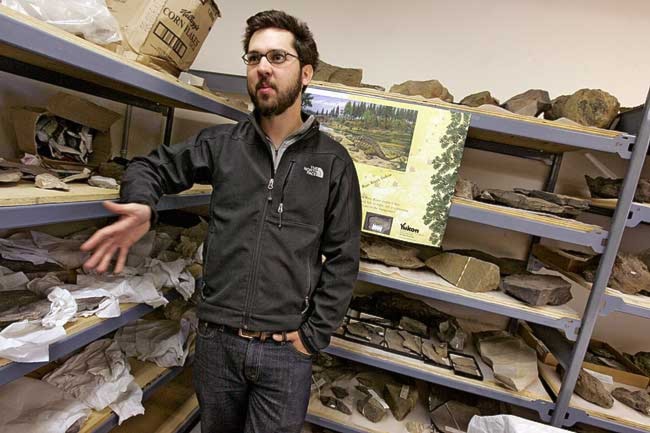Dinosaur-era fossils discovered in the Yukon’s Peel Watershed last week have scaled up debate over the fate of the wilderness area.
“(Fossil sites) give another little bit of a reason to go slow and carefully in developing these areas until we know exactly what we have,” said Blaine Walden, vice-president of the Wilderness Tourism Association of the Yukon.
“There is more to economics than just resource extraction.”
In the last five years, more than 10,000
mining claims have been staked in the Peel Watershed—mainly for coal, iron and uranium.
A draft land-use plan only calls for 12 per cent of the watershed to be protected from mineral extraction.
Conservation and tourism groups are calling for 50 per cent.
“A significant find of fossils or dinosaur bones is unique, and is worth way more than that coal will be,” said Walden.
Research trips to new dig sites could be key moneymakers for the territory.
“Helicopter time, float plane time, local hires ... it’s money that comes in, stays in the Yukon, and has little effect on the land,” he said.
Paleontological sites are also a prime draw for ecotourists, added Walden, who conducts guided canoe trips throughout the Canadian North.
Pulling out bones, rather than coal, iron or uranium, doesn’t affect caribou herds or other wildlife, he said.
On Tuesday, the Peel Planning Commission accepted its last public comments.
“Some of these sites are world class,” said Walden. “If we can get some kind of protection around them, and then the word gets out to the scientific community, it’s a huge economic boost to the territory.”
At first glance, the bones seem insignificant.
And in any other paleontological dig, they would be.
Take a walk in the Badlands of Alberta, and you’ll find similar fossils “within minutes,” said David Evans, an associate curator at the Royal Ontario Museum and a member of the three-person dig team.
“It wouldn’t even be collected,” he said.
One is a tiny pebble believed to be the toe bone of a soft-shelled turtle. The other, a hand-sized fragment from a duck-billed dinosaur.
The real value of the tiny fragments is their location.
With proof that dinosaurs lived in the prehistoric North, researchers can shine light on one of paleontology’s greatest mysteries: what caused the extinction of the dinosaurs?
For years, paleontologists have largely believed either that dinosaurs succumbed to climate change, or were wiped out by an asteroid that kicked up enough dust to plunge the planet into months of darkness.
However, the Peel bones were found just south of the Arctic Circle.
Taking continental drift into account (which would put the site even closer to the North Pole), the team is left with evidence that dinosaurs could survive both cold and darkness.
“Even though there were no ice caps, you still had six months of total darkness,” said Evans.
Although the Earth was much hotter in the time of the dinosaurs, temperatures in northern latitudes could still drop as low as freezing.
If a flock of duck-billed dinosaurs could survive six months of night and winter temperatures as low as zero degrees, it seems unlikely that they would be wiped out merely by an asteroid or climate change.
“They were a lot hardier,” said Evans.
The team also unearthed a number of prehistoric plants—which present their own mysteries.
Amazingly, pre-extinction and post-extinction fauna are almost identical.
Whatever killed the dinosaurs didn’t seem to have it out for plants.
Also remarkable is how millions of foraging dinosaurs could instantly be killed off, but forests would retain their pre-extinction shape, regardless.
“If you took all the cows, horses and moose off the plains of North America, the forests and the grasslands would change ridiculously,” said Yukon paleontologist Grant Zazula.
“So why don’t the plants change when the dinosaurs go out?” he said.
The Peel plants have also revealed a prehistoric world largely unaffected by changes in latitude.
Zazula picked up a flat-sided rock that carried the 65-million-year-old imprint of a dawn redwood—a species of sequoia now found only in China.
Similar sequoias are known to have grown in dinosaur-age Louisiana.
It’s almost like having polar bears roaming modern-day Texas.
“How does the Earth function without any changing diversity in latitude?” said Zazula.
All over the Yukon, fossil-rich rock is rising to the surface, revealing Mesozoic (dinosaur-era) deposits.
Alaska’s North Slope—although renowned for its oil reserves—has also revealed a treasure trove of dinosaurs in less liquid forms.
The fossils of twelve species of dinosaurs have been discovered in North Alaska, including a tyrannosaur.
“Jealousy” has motivated Canadian paleontologists to start scouring their own northern latitudes for fossils, said Evans with a laugh.
“(The North) is the last frontier in looking for dinosaurs,” he said.
Dinosaur bones, like the Klondike Gold Rush, could soon be selling Yukon-bound plane tickets.
Drumheller, Alberta, located at the centre of Alberta’s fossil-rich badlands, has become a Canadian pioneer in dinosaur tourism.
Every year, the city welcomes thousands of tourists arriving to tour active dig sites.
Yukon dig sites aren’t as easily visited.
To get to the Peel site, helicopter transport alone would cost tens of thousands of dollars.
Most of Drumheller’s visitors, however, are content to spend their tourist dollars without ever setting foot on a dig site, said Barry Fullerton, general manager of the Drumheller Chamber of Commerce.
“Where (Dinosaur Provincial Park) sees 75,000 tourists a year, we’ll see 500,000 tourists a year,” said Fullerton.
Dinosaur-rich badlands may have given Drumheller its reputation, but attractions such as the Royal Tyrrell Museum and the world’s largest model dinosaur are what makes the town a destination.
Contact Tristin Hopper at
tristinh@yukon-news.com
